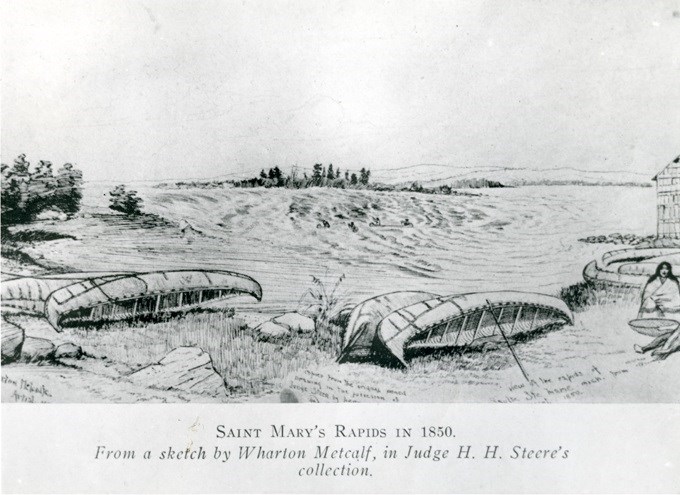From the archives of the Sault Ste. Marie Public Library:
When you think about the stories behind pieces of scenic artwork, you probably wouldn’t imagine an uprising at a mine. However, that’s exactly the case with these drawings by Wharton Metcalfe, which are linked to the Mica Bay Incident – an occurrence still talked about to this day.
It started in 1849, in Mica Bay, an area north of Sault Ste. Marie that included Quebec and Lake Superior Mining Association holdings.
Tensions had been mounting between Indigenous people and settlers mining in the area. There had been an increasing push from Indigenous people to be able to manage their own resources, and to be compensated for the resources that were found on their lands. The government, however, was not willing to provide compensation for valuable mining locations, nor participate in any negotiations – a refusal which flew in the face of Indigenous law and the Royal Proclamation of 1763.
Rumours started to fly that Indigenous leaders were planning to take over the mine at Mica Bay, to place further pressure on the government. In November, reports came in that a group set out for the mine by boat.
The group consisted of Chief Nebenagoching, American Head Chief Cassaquadung, and Chief Shingwaukonse. Dozens of Ojibwe and Metis people participated, some travelling by boat and others moving over land. Also involved were three white men — two were lawyers and the third was an artist by the name of Wharton Metcalfe.
Their goal was to take over Mica Bay, remove the manager from his position, and turn mining operations over to the Indigenous people.
Store owners in Sault Ste. Marie reported that, as the group headed out of town toward the mine, they armed themselves with muskets and knives. They also brought two small Hudson’s Bay Company cannons that had previously been located on Customs Collector Joseph Wilson’s lawn.
On their way, members of the group lit several fires along the Lake Superior coastline, enabling them to appear greater in number than they actually were.
What actually happened when they arrived in Mica Bay became the subject of some disagreement. Wildly different stories arose – both from those present and from the newspapers reporting on the incident.
There were threats of violence, according to the mine manager’s account. Wharton Metcalfe may even have held him at gunpoint while other members of the group brandished knives. The cannon was fired once. The mine’s operations ceased in response, and people were evacuated.
Some news reports ran with the story, with one newspaper going so far as to suggest there were 150 people killed in the takeover; however, there were no actual deaths, and it was generally agreed to be a non-violent event.
Troops were brought north to deal with the mine takeover and quell any unrest. Approximately 100 soldiers with the Toronto Rifle Brigade set out for Mica Bay, but soon got held up due to bad weather. They were forced to spend the winter in the Sault’s Hudson’s Bay Company Fort instead of continuing on to the mine.
Fortunately no military enforcement was necessary. With rumours, misinformation, and misrepresentation of the events in the news, the group opted to surrender peacefully. They were arrested quickly and without incident, brought to Toronto, and held briefly before being released.
The Mica Bay Incident turned out to be a tipping point in settler/Indigenous relations, pushing the government to negotiate treaties with the Indigenous peoples. It was one of the factors that directly led to the signing of the 1850 Robinson-Huron Treaty.
As for Wharton Metcalfe, he was arrested. After being released, he briefly and repeatedly fled the country – escaping to Sault, Michigan, venturing back over to the Canadian side, being caught by authorities, and repeating the process. Over the winter, while in Sault, Michigan, he drew some local scenes, including these images of the downtown area and the rapids.
Not much is known about Metcalfe after his involvement in the Mica Bay incident. dHe eventually left North America for England and found some success there as a watercolour artist.
Each week, the Sault Ste. Marie Public Library and its Archives provides SooToday readers with a glimpse of the city’s past.
Find out more of what the Public Library has to offer at www.ssmpl.ca and look for more Remember This? columns here
